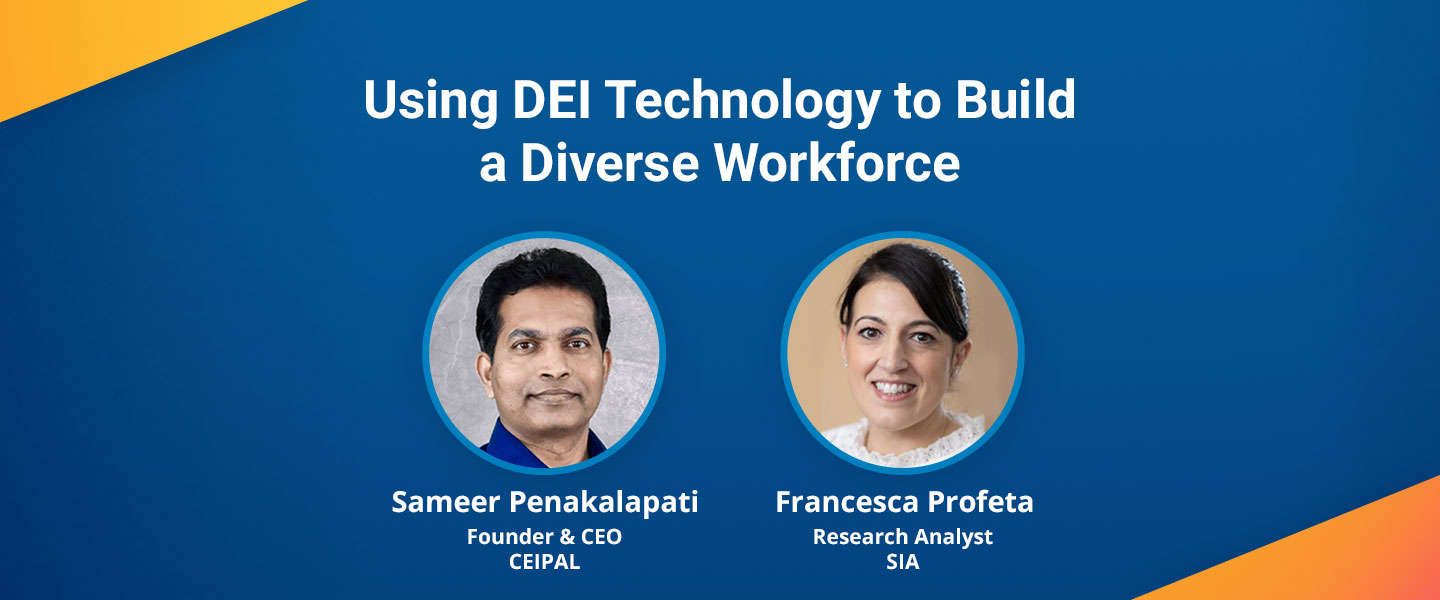Missed our webinar with Ceipal Founder & CEO Sameer Penakalapati and SIA’s Francesca Profeta? Don’t worry, you can watch it at your convenience! Please watch the full webinar by clicking on the video link above.
Key Points Discussed
Research shows companies that hire from a more diverse pool of candidates create a better workforce and have a strategic advantage. Accordingly, 90% of organizations say seeking diverse candidates is a top priority. So, how can staffing firms intentionally champion diversity and inclusion and get the best talent for their clients? Recently our CEO Sameer Penakalapati sat down with SIA’s Lead Diversity Research Analyst Francesca Profeta to share their experiences identifying, curating, and growing diverse candidate pools to help build greater diversity within the workforce.
Companies understand workplace equity is not only the moral thing to do but that it provides a strategic and financial advantage. For example, companies with an executive team with gender diversity were 25% more likely to experience above-average financial performance than their peers in the fourth quarter.
Many companies champion diversity, equity, and inclusion (DEI) for their workforce and are creating goals. However, there are significant barriers to hiring a diverse workforce. Historically many companies lacked a corporate mandate to apply diversity and inclusion to the contingent workforce. When companies start to talk about diversity they look at their staffing partners. But many lack clarity from staffing partners about the demographics of their talent, why ownership diversity might not mean actual diversity of their talent or they might have limited demographic data. These are all major barriers to creating a diverse contingent workforce.
For staffing providers and practitioners to create a diverse workforce they need to establish how to assess diversity, create a plan, and then execute against their plan and ensure that they are mapping to goals. The key to understanding the contingent workforce is access to accurate data points across the entire talent acquisition process.
During this discussion attendees learned the four steps that are crucial to attracting more diverse candidates, establish a stronger hiring practice, and ultimately meet your organization’s corporate diversity goals:
- Establish a Diversity Baseline: Providers and practitioners need to understand the diversity of their existing contingent workforce to identify talent gaps needed to establish DEI objectives. One approach is to use an AI-powered assessment solution to evaluate and create a baseline of their contingent workforce distribution by gender and ethnicity with ease. This is a simple non-intrusive way to accurately assess any workforce and it only requires a list of worker names and locations.
- Addressing the Diversity Gap: Once the baseline is established then staffing professionals can analyze their workforce data and map out a strategy. Using an AI-powered assessment technology can analyze current diversity gaps and help create a strategy to reduce any gender or ethnic gaps within your workforce. The resulting plan will be realistic and comprehensive, addressing all source points to help build a more diverse workforce.
- Creating a Diverse Talent Pool: All talent sources need to be evaluated to ensure they are appropriately populated with diverse talent otherwise they will never have access to the talent needed to reach DEI goals. Talent sources can be analyzed by using a unique AI Diversity Algorithm that provides actionable insights to improve diversity. This will create a robust ‘talent container’ of active and passive candidates and use AI Search and Ranking to align talent to workforce needs on-demand. It will help measure key performance metrics and report on progress against goals in real-time as you build a more diverse and inclusive workforce.
- Tracking DEI Performance: This is crucial. Like all goals, it is important to conduct periodic checks to track progress against established DEI goals. Use a robust ‘talent container’ of active and passive candidates and AI Search and Ranking to align talent to workforce needs on-demand. Tracking needs to include reports that measure key DE&I metrics and report on progress against goals in real-time. This will enable practitioners to continuously build a diverse and inclusive workforce.
For example, let’s look at staffing firms. Their client is concerned about contingent workforce diversity, equity, and inclusion, but isn’t sure where to start or what to do about it.
The client knows there are diversity gaps in their contingent workforce but doesn’t have any appropriate or available means for gathering data and completing a gap analysis. One way to gather the data and analyze it is to use AI technology to assess the client’s current workforce for gender and ethnic diversity to identify any gaps and develop a strategy that maps to diversity goals.
An implemented DEI strategy does not mean work is over. Workforces are always in flux at companies, so they should be examined quarterly to determine the diversity of your team and identify any gaps. It is important to understand that building a diverse pool is a process and not a quick-fix solution. This might seem daunting and overwhelming, but the rewards are well worth the effort.











